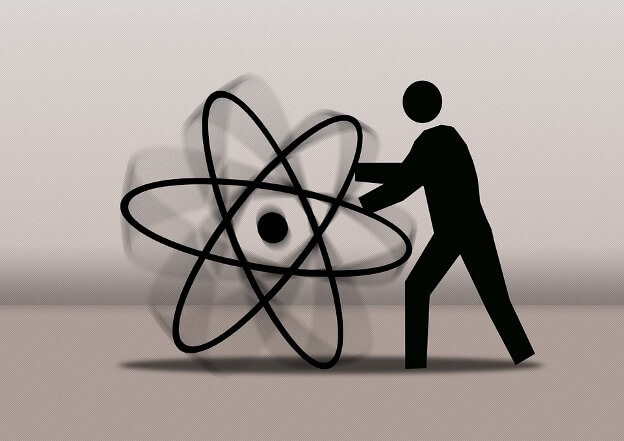Accept nuclear power plants.
Currently, they are our best option towards producing CO2 free electricity.

“A nuclear power plant is infinitely safer than eating, because 300 people choke to death on food every year.”
-Dixie Lee Ray
Hey there, folks!
We’d like to start by stressing out the importance of this week’s challenge. Since nowadays most of the countries have democratic systems, the public has the power to shut down nuclear power plants as it happened in Germany. And let’s be honest, the general public all around the world knows very little about the nuclear power let alone about the nuclear power plants.
We are built in a way that makes us fear the unknown. But at the same time, it seems a bit strange to have the power to decide about something we don’t know. Right? That’s why we believe it is only fair for the general public to learn a thing or two about nuclear power plants (NPPs).
Nuclear power plants
Most people think of nuclear bombs as soon as they hear the word nuclear. Sure, they both use the same physical phenomena called fission, however, there is one major difference between the two. One is taking a potentially incredibly useful invention and turning it into something wicked and horrible, while the other is actually using the science to bring us all the “green” energy. Unfortunately, most of the power plants out there are still using fossil fuels.

In general, nuclear power plants use the same principals as the thermal power plants. Essentially, the main difference is the type of fuel they use. Most of the thermal power plants burn either charcoal or gas, which produces greenhouse gases that are released into the atmosphere.
While most of the nuclear power plants use enriched uranium as a fuel (some use natural uranium). It produces no CO2 or any other greenhouse gases. Furthermore, the entire primary system (t.i. the enclosed part of the nuclear power plant where the reactor core transfers the heat to the primary coolant) is sealed so no radioactive material is released into the environment.
For the record, the “smoke” that can be seen around nuclear power plant (like on the first photo above) is actually a clean (t.i. non-radioactive) steam coming out of the cooling towers.
“All the waste in a year from a nuclear power plant can be stored under a desk.”
-Ronald Reagan
After reading the last two paragraphs, many of you must be thinking about the nuclear accidents. Right? Well, you should know a few things about that too.
The truth about NPP accidents
There are many nuclear power plants operating around the world (400 to be exact). So, with that kind of a number of any complex system, which NPP sure is, you have a certain degree of risk. However, the nuclear power plants have one of the most strict and thorough international systems in place to ensure that accidents are kept to a bare minimum. There are many international organizations to keep it all under close watch (unlike with other types of power plants).

Even though we all wish there haven’t been any NPP accidents, the number of those is reasonably low. There have been only three bigger NPP accidents so far: Chernobyl, Three Mile Island, and Fukushima. Unfortunately, there very many casualties, however far less than in charcoal power plants or even hydro power plants related accidents. But you’ve probably never even heard of those before.
Fossil fuels are far deadlier than nuclear power. For each person killed by nuclear power generation, 4,000 die from coal. Just to paint you a clearer picture, the IAEA and the UN estimate that the death toll from cancer following the 1986 Chernobyl meltdown will reach around 9000, while fine particles from coal power plants kill an estimated 13,000+ people each year in the US alone.
You all know the strength of the fossil fuel lobbies, don’t you? Well, they are the ones that tend to finance and support most of the anti-nuclear propaganda. You shouldn’t fall for those. Please, use your own head.
Are nuclear power plants green?
According to general belief, they are not. However, if you ask the scientific population, the decision is split. Well, if you ask us they are. The same as solar, wind, tidal, wave, and hydroelectric power plants, nuclear ones also do not produce greenhouse gases. Moreover, the nuclear material released into the environment is kept way below the natural background.
It would be great if we could all get enough energy from the solar, wind, tidal, wave, and hydroelectric power plants, but this is not possible, at least not for now. On the other hand, NPPs are the realistic solution that’s is right in front of our noses.
“Only nuclear power can now halt global warming.”
-James Lovelock
Radioactivity
Radioactivity is the part that really frightens the common man. You should know that radioactivity is something we all deal with every single day. Radioactivity is natural. There are radioactive nuclides in the atmosphere, in the ground, in the water, and even inside of every single person (radionuclide K-40).

Moreover, you get way more radioactive exposure due to the natural radioactivity (radionuclide called radon) than the average worker in the nuclear power plant. Not to mention the doses (t.i. the amount of the energy of ionizing radiation accumulated per unit mass of tissue) you receive during the X-ray or the CT scan.
Even when you take a flight, you get more exposure to radiation than the average NPP worker on his average workday. Furthermore, pilots are way more exposed to the radiation than the NPP personnel.
Bottom line is, the radioactivity is something that must be dealt with respect and caution, especially when it comes to higher dose rates. However, the radiation from NPPs is not something you should be afraid of.
Take-home points:
-
Accept nuclear power plants.
-
NPPs are the only power plants type able to provide “green” electricity for the whole world.
-
Support nuclear power plants.
-
Fossil fuels are far deadlier than nuclear power.
-
Radioactivity is natural.
Have a nice week.
Love,
Good Earthlings

Great information on the benefits of nuclear power plants. Like you, I also would like my electricity to be generated from clean power source, but sadly that’s not possible. Not to mention the land mass needed to build a sufficient solar or wind farm is enormous. Hydro power plants on the other hand will destroy our river natural environment, often times greatly.
This, I totally agree that nuclear is the way to go. But with the fukushima incident happening to one of the most hardworking nations in the world, the sceptics were right in this sense. But I believe with the findings from that incident, IAEA can beef up their standards to be imposed on NPPs all over the world =)
Hey, Isaac!
We agree that the Fukushima accident was a hard blow for NPPs all around the world. However, the irony of Fukushima is that in making us confront our deepest fears about the dangers of nuclear power, we found many of the scare stories generated by the anti-nuclear movement over many years to be wildly irrational.
You have to know, that the effect of Fukushima are much less than some media coverage might suggest.
All best, GE
Nuclear power is the future, and the sooner the powers that be are able to make the plants totally green and even safer, the sooner we all can benefit, and stop depending on ancient dinosaur bone soup to power our machines! When there’s an accident, it’s terrifying, but I appreciate you pointing out that deadly accidents and sicknesses are far more common with coal.
Hi there, Penelope! Thank you for sharing your thoughts with us. Stay around.
Warm regards, GE